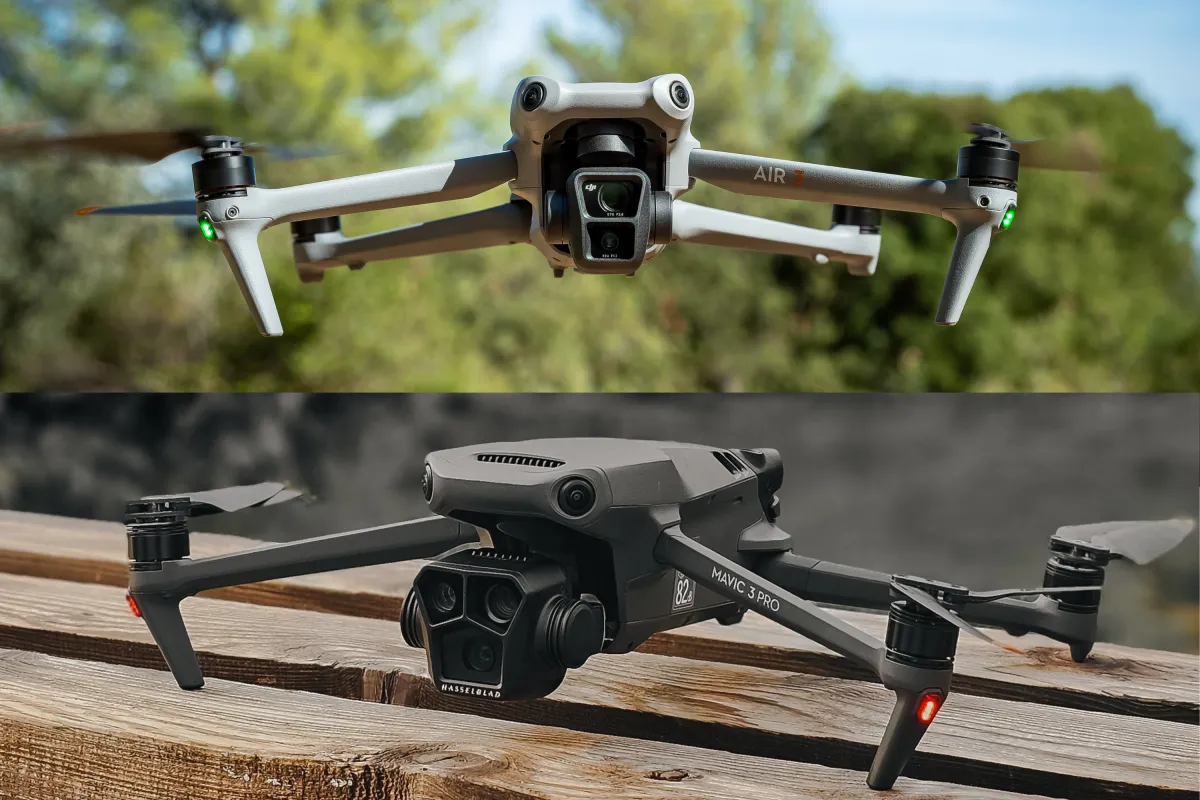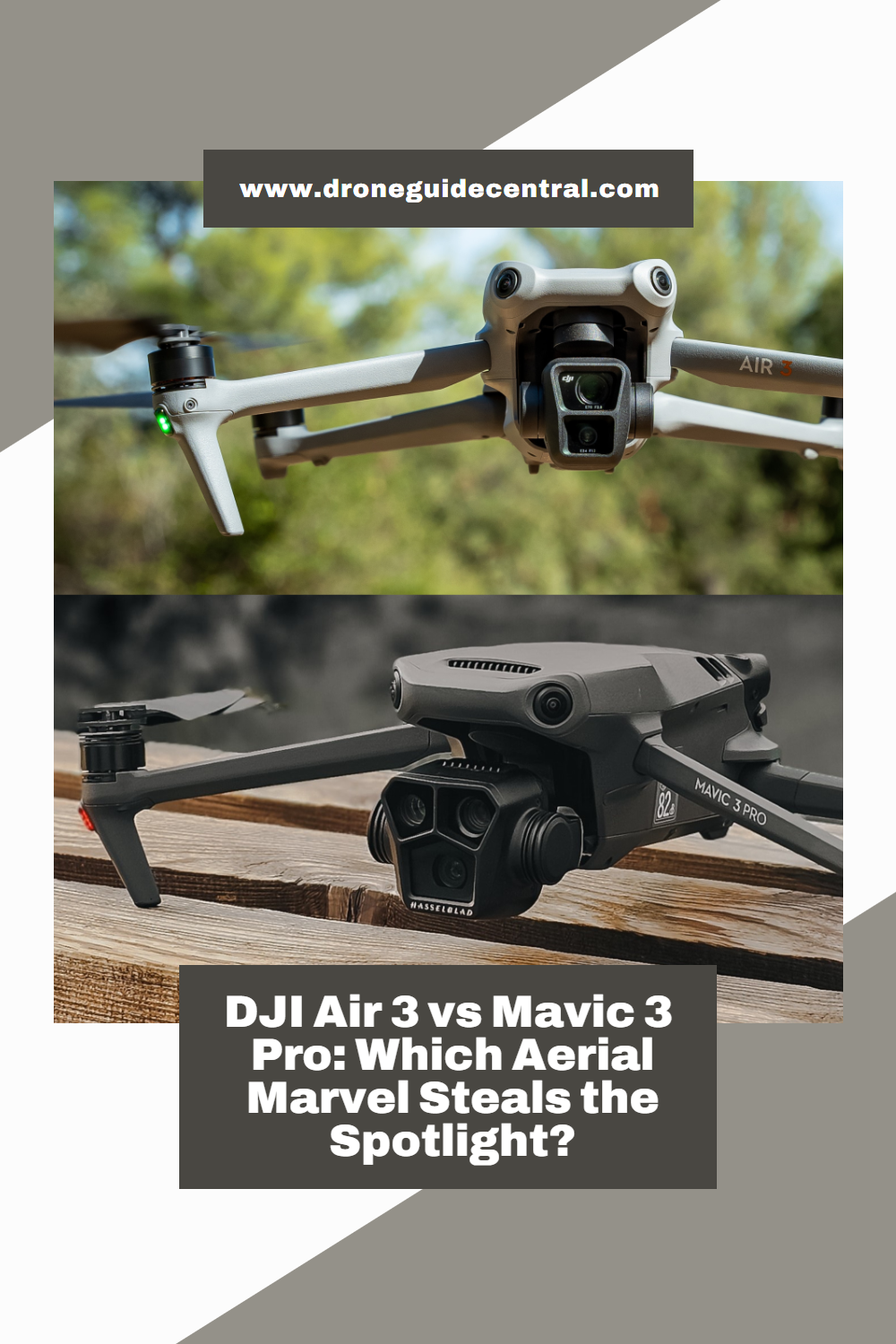
DJI Air 3 vs Mavic 3 Pro: Which Aerial Marvel Steals the Spotlight?
In the dynamic world of drones, two contenders have been making waves. I've scrutinized both models to provide you with an insightful comparison of the DJI Air 3 vs Mavic 3 Pro. Let's embark on this aerial journey.
DJI Air 3
Technical Specifications
Weighing a nimble 1.58 lb / 720 g, the DJI Air 3 doesn't skimp on features. With an impressive maximum ascent and descend speed of 22 mph (10 m/s) and a staggering altitude capability of 19685 ft / 6000 m, it promises an exhilarating flight experience. Its robust wind resistance of 26.8 mph (12 m/s) ensures stability even in challenging weather conditions.
Design and Build
The DJI Air 3's sleek design isn't just eye-catching; it's engineered for optimal performance. Its 3-axis mechanical gimbal ensures steady footage, eliminating the notorious "jelly effect" from shaky hands or gusty winds.
Camera Capabilities
With its combination of wide-angle and medium tele cameras, the Air 3 provides flexibility for various shooting scenarios. Whether aiming for expansive panoramas or intricate details, its twin-camera configuration delivers clear and dynamic visuals. Additionally, it supports vertical shooting in 2.7K for both lenses, automatically formatting images for effortless sharing on social platforms or with friends and family.
DJI Mavic 3 Pro
Technical Specifications
Tipping the scales at 2.11 lb / 958 g, the Mavic 3 Pro is a tad heavier but comes with its set of advantages. It boasts a trio of cameras, each with its unique focal length. Sporting an ascent speed of 17.8 mph (8 m/s) and a descent speed of 13.4 mph (6 m/s), it showcases respectable vertical maneuverability, coupled with an impressive altitude limit of 19,685 ft (6000m). With wind resistance on par with the Air 3 at 26.8 mph (12 m/s), it ensures steady flights even when faced with challenging gusts.
Design and Build
With its sturdy build and aerodynamic design, the Mavic 3 Pro is built for endurance and precision. Its refined aesthetics are a testament to its advanced engineering. Its 3-axis mechanical gimbal, paired with 3 cameras: Hasselblad, Medium tele camera, and tele camera, ensures cinematic footage with unmatched clarity.
Camera Capabilities
The Mavic 3 Pro's 4/3 inch CMOS Hasselblad Camera stands as a testament to its commitment to quality. It's ideal for wide-angle shots and capturing expansive landscapes. Medium tele camera excels in capturing subjects with a balanced blend of zoom and detail. It is suited for scenarios where a more zoomed-in perspective is desired. Tele camera is designed for capturing distant subjects with exceptional detail. Perfect for scenarios where extensive zoom capabilities are essential, such as wildlife or architectural photography.
DJI Air 3 vs Mavic 3 Pro: Head-to-Head Comparison
Weight and Dimensions
The DJI Air 3's lighter design makes it more portable and ideal for on-the-go adventures. When folded (excluding propellers), it measures 8.15 × 3.96 × 3.59 inches / 207×100.5×91.1 mm (L×W×H). In contrast, the Mavic 3 Pro's larger frame offers stability. When folded (excluding propellers), it spans 9.10 × 3.86 × 3.76 inches /231.1×98×95.4 mm (L×W×H).
Speed
Both drones are no slouches in the speed department maxing the speed at 47 mph (21 m/s). However, the DJI Air 3's superior ascent and descend speed might appeal to people seeking rapid ascents and dives.
Flight Time and Resistance
Boasting a flight duration of 46 minutes, the DJI Air 3 promises prolonged airborne escapades, slightly outpacing the Mavic 3 Pro's 43-minute runtime. While both drones excel with a wind resistance of 26.8 mph (12 m/s), the Air 3's extended flight time could be a decisive factor for some enthusiasts.
DJI Air 3 vs Mavic 3 Pro: Camera Specifications
DJI Air 3 is equipped with a 1/1.3-inch CMOS sensor for both its wide-angle and medium tele lenses, delivering a sharp 48 MP resolution. Its 24 mm wide-angle lens captures vast landscapes beautifully, with the f/1.7 aperture ensuring impressive low-light performance. Capable of recording in 4K across various frame rates, the Air 3 delivers vivid video quality. Its dual-camera system elevates its adaptability to diverse videography needs.
On the other hand, both drones share a 70 mm medium tele lens with a 1/1.3-inch CMOS sensor, ensuring top-notch image quality. This lens is a favorite among photographers seeking a mix of magnification and clarity, especially for capturing subjects with a flattering perspective and background blur.
Yet, the DJI Mavic 3 Pro edges ahead with its triple camera system and different focal lengths. Its primary Hasselblad lens boasts a larger 4/3-inch CMOS sensor with a 20 MP resolution. Optimized for wide shots, its variable aperture from f/2.8 to f/11 adapts seamlessly to varying light conditions. The Mavic 3 Pro impresses further with video capabilities, reaching up to 5.1K resolution, and stands out as a formidable choice for videographers.
The Mavic 3 Pro's 166 mm tele lens is a marvel for those desiring remarkable zoom prowess. This lens, backed by a 1/2-inch CMOS sensor, guarantees clarity even at significant magnifications.
DJI Air 3 vs Mavic 3 Pro: Usability and Features
Internal Storage
Both models generously provide 8 GB of internal storage, ensuring you never miss a moment due to storage constraints.
Intelligent Flight Modes
Offering a spectrum of features, from user-friendly modes to intricate flight settings, both drones are tailored to accommodate pilots of varying expertise, guaranteeing a smooth flight experience. They are equipped with state-of-the-art features like FocusTrack, QuickShots, MasterShots, Hyperlapse, Slow Motion, Waypoints, and Course control.
Video Transmission and Distance
Both drones prioritize an uninterrupted flying experience, with their robust video transmission systems delivering clear and real-time footage, elevating your aerial journeys. The DJI Air 3 is equipped with advanced O4 technology, boasting a transmission range of 12.4 miles / 20 km (FCC) and 6.2 miles / 10 km in other regions. Meanwhile, the DJI Mavic 3 Pro features the O3+ technology, offering a transmission distance of up to 9.3 miles / 15 km and 4.9 miles / 8 km in other areas.
Price Point and Value
Both drones offer exceptional value and unparalleled aerial experiences. DJI Air 3 starts at $1,099 and DJI Mavic 3 Pro is priced at $2,199.
DJI Air 3 vs Mavic 3 Pro: Pros and Cons
DJI Air 3
Pros:
Max flight time - 46 mins
Light and powerful
Dual 4K cameras
Max transmission distance of 12.4 miles / 20 km
Omnidirectional obstacle sensing technology
Cons:
Fixed aperture
FAA Registration required
DJI Mavic 3 Pro
Pros:
Triple camera
Hasselblad camera 5.1K
Max flight time - 43 mins
Max transmission distance of 9.3 miles / 15 km
Omnidirectional obstacle sensing technology
Cons:
Heavy (Restricted in Europe and other countries)
High price
FAA Registration required
Conclusion
Choosing between the DJI Air 3 and the Mavic 3 Pro is akin to selecting between two masterpieces. Both drones offer unparalleled features, ensuring a memorable flying experience. Both models excel photographically. The DJI Mavic 3 Pro appeals more to professionals or videographers prioritizing pristine quality, while the DJI Air 3 offers a budget-friendly option without skimping on performance. Your choice will reflect what matters most to you, whether it's portability, camera capabilities, or budget.
DJI Air 3 vs Mavic 3 Pro: FAQs
Which drone offers superior camera quality for landscape photography?
While both drones excel in landscape photography, the Mavic 3 Pro holds a slight advantage with its triple-camera setup. The inclusion of a Hasselblad camera, coupled with its adjustable aperture and 5.1K recording capability, elevates its performance. For those aiming to elevate their photography and videography, the DJI Mavic 3 Pro Cine, offering Apple ProRes formats and advanced color sampling techniques, stands out as the preferred choice.
How does the Mavic 3 Pro's weight impact its flight performance compared to the DJI Air 3?
The Mavic 3 Pro is heavier than the DJI Air 3. Generally, a heavier drone has more stability in windy conditions due to its increased mass. However, it might also consume slightly more power during flight, potentially reducing its overall flight time compared to a lighter drone like the DJI Air 3. The specific impact on flight performance would also depend on other factors like motor power, aerodynamic design, and flight algorithms.
Do both drones support 4K video recording at high frame rates?
Yes, both the Mavic 3 Pro and the DJI Air 3 support 4K video recording. The DJI Mavic 3 Pro even goes a step further with its capability to record in 5.1K resolution. While the exact frame rates and resolutions might differ between the two models, they are both equipped to capture high-definition footage, making them suitable choices for professional videography and photography.
What is the maximum transmission distance for each model under optimal conditions?
For the DJI Air 3, the maximum transmission distance is 12.4 miles /20 km. On the other hand, the DJI Mavic 3 Pro offers a maximum transmission distance of up to 9.3 miles / 15 km. These distances represent optimal conditions with minimal interference.
Which drone offers a more user-friendly interface for beginners?
DJI drones are known for their user-friendly interfaces designed to cater to both beginners and professionals. However, specific preferences may vary based on individual experiences and familiarity with the brand's ecosystem. For those venturing into the realm of drones for the first time, I recommend commencing with one of the DJI Mini series models.

Copyright © Drone Guide Central - All Rights Reserved 2024

